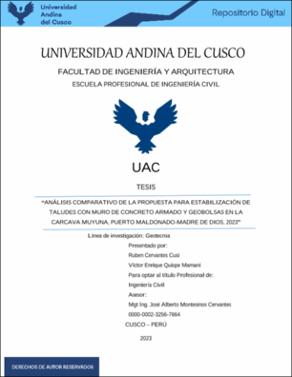Análisis comparativo de la propuesta para estabilización de taludes con muro de concreto armado y geobolsas en la Carcava Muyuna, Puerto Maldonado-Madre de Dios, 2023

Date
2023-06-22Author
Cervantes Cusi, Ruben
Quispe Mamani, Víctor Enrique
Advisor
Montesinos Cervantes, José Alberto
Metadata
Show full item recordAbstract
La presente tesis de investigación titulada “ANÁLISIS COMPARATIVO DE LA
PROPUESTA PARA ESTABILIZACION DE TALUDES CON MURO DE CONCRETO
ARMADO Y GEOBOLSAS EN LA CARCAVA MUYUNA, PUERTO MALDONADOMADRE
DE
DIOS,
2023”,
propone
analizar
y
comparar
la
estabilidad
del
talud
con
un
muro
de
concreto armado y con la implementación de muro con geobolsas, esto cumple con los
parámetros de diseño y viabilidad en cuanto a costo/beneficio y tiempo/beneficio, esto ayuda a
mitigar los deslizamientos y evitar daños a las construcciones aledañas en la cárcava de
Muyuna. Para los estudios preliminares se obtuvo la inspección in situ del talud realizando un
levantamiento topográfico que nos proporcionó el perfil de la misma, para conocer las
propiedades físicas y mecánicas del suelo del talud, se realizó 8 calicatas a lo largo de la zona
de estudio, ubicado entre las progresivas secciones 0+000 km a 0+440 km del cual se realizaron
los ensayos en laboratorio. Para ello, se analizará dos propuestas de solución en 3 secciones
críticas de la cárcava Muyuna en relación a los datos obtenidos.
Para el diseño de propuestas se utilizó el software Geotécnico GEO 5, utilizamos los datos
obtenidos como el ángulo de fricción, peso específico y cohesión del suelo los cuales fueron
obtenidos en los Ensayos en laboratorio; resultando un factor de seguridad para el muro de
concreto armado el valor de 1.51 y para el muro de geobolsas un valor de 1.51, resultando
ambos métodos favorables en cuanto a la estabilidad. Por otro lado, se efectuó un análisis de
costo/beneficio en el programa S10 y tiempo/beneficio en el programa Project MS con la
conformación de análisis de precios unitarios y programación para cada partida que requiere la
elaboración de ambos muros. Como resultado obtuvimos que el costo para muro con geobolsas
en un tramo de 1 metro lineal resulto s/. 3,696.53 soles y el costo de la implementación de muro
de concreto armado resulto s/. 8,637.80 soles; resultando como mejor opción económicamente
la implementación de muro con geobolsas. Y el tiempo de ejecución de muro con geobolsas
resulto 9 días y el tiempo de ejecución de muro de concreto armado resulto 14 días; resultando
como mejor opción en cuanto a tiempo de ejecución la implementación de muro con geobolsas.
Concluyendo que la implementación de muro con geobolsas resulta más viable respecto a la
estabilización del talud, costo/beneficio y tiempo beneficio en un suelo ineficiente a la
estabilidad del talud. This research thesis entitled "COMPARATIVE ANALYSIS OF THE PROPOSAL FOR
SLOPE STABILIZATION WITH REINFORCED CONCRETE WALL AND GEOBOLLS IN
LA CARCAVA MUYUNA, PUERTO MALDONADO-MADRE DE DIOS, 2023", proposes
to analyze and compare the stability of the slope with a concrete wall. reinforced concrete and
with the implementation of a wall with geobags, this complies with the design and feasibility
parameters in terms of cost/benefit and time/benefit, this helps to mitigate landslides and
prevent damage to surrounding buildings in the Muyuna gully. For the preliminary studies, the
in situ inspection of the slope was obtained by carrying out a topographic survey that provided
us with its profile, to know the physical and mechanical properties of the soil of the slope, 8
pits were made throughout the study area, located between the progressive sections 0+000 km
to 0+440 km of which the laboratory tests were carried out. For this, two solution proposals
will be analyzed in 3 critical sections of the Muyuna gully in relation to the data obtained.
For the design of proposals, the Geotechnical software GEO 5 was used, we used the data of
friction angle, specific weight and cohesion which were obtained in the Laboratory Tests;
obtaining a safety factor for the reinforced concrete wall that is 1.51 and for the wall with
geobags equal to 1.51, resulting in the most optimal implementation of the reinforced concrete
wall design. On the other hand, a cost/benefit analysis was carried out in the S10 program and
time/benefit in the Project MS program with the formation of unit price analysis and
programming for each item that requires the elaboration of both walls and as a result we
obtained that The cost for the wall with geobags for a section of 1 linear meter resulted in s/.
3,696.53 soles less than the cost of the reinforced concrete wall, which was equal to s/. 8,637.80
soles and the execution time of the wall with geobags was 9 days less than the execution time
of the reinforced concrete wall, which was equal to 14 days. Concluding that the
implementation of a wall with geobags is more viable regarding the stabilization of the slope,
cost/benefit and benefit time in a soil that is inefficient for slope stability.

